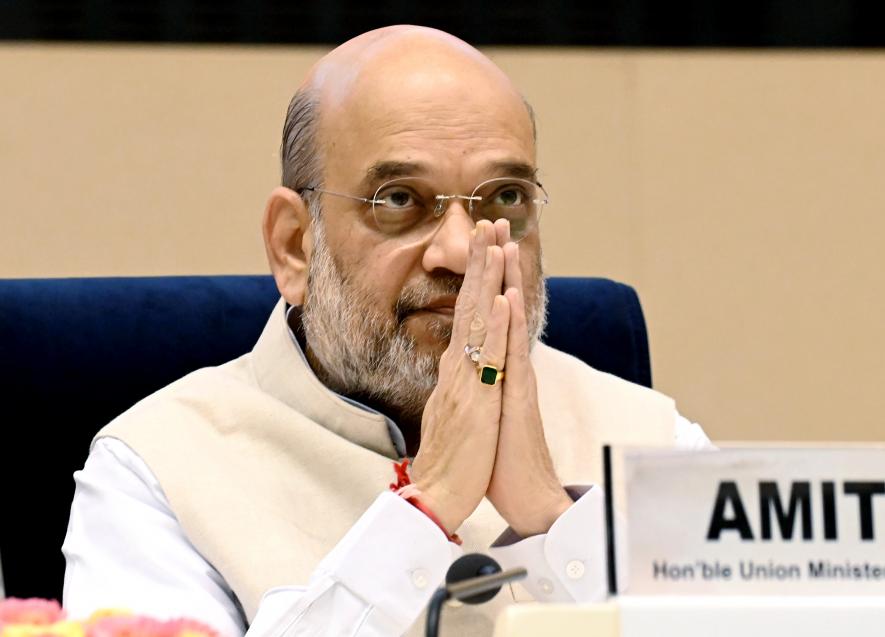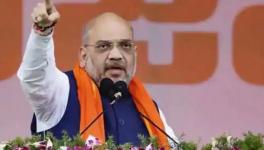August 5 -- What’s in a Date, Mr Amit Shah?

Union Home Minister Amit Shah at the 100th International Day Of Cooperatives organized Jointly by the Ministry of cooperation and the national cooperative union of India. Representational Image. Image Courtesy: ANI
Union Home Minister, Amit Shah, last week took exception to the Congress party and its leaders, especially Rahul Gandhi and his sister, Priyanka.
Their crime in this instance? Well, the GOP (Grand Old Party) scheduled its nationwide protests against price rise and unemployment on August 5, which Shah stated was a much-rejoiced and sacrosanct day because Prime Minister Narendra Modi performed Bhoomi Pujan for the Ram temple on this day in 2020.
Shah was particularly riled because the Gandhi siblings wore black clothes during day-long skirmishes with security forces as a sign of protest.
Effectively, Shah was arguing that post-2020, August 5 must be put on the same pedestal and accorded the same respect as major national commemorations are accorded, like Independence Day and Republic Day.
आज ही के दिन @narendramodi जी ने श्रीरामजन्मभूमि मंदिर का शिलान्यास किया था, इसलिए कांग्रेस तुष्टिकरण के लिए ये विरोध कर रही है।
ED व महंगाई तो सिर्फ बहाने हैं...कांग्रेस का असली दर्द श्री राम मंदिर का बनना है।
आज तो कांग्रेस ने एक कदम और आगे बढ़ काले कपड़े पहनकर विरोध किया है। pic.twitter.com/g8cOjGjmm5
— Amit Shah (@AmitShah) August 5, 2022
It goes without saying that any protest, on any matter, on these days is a sure symptom of treason and subversive behaviour.
Before going further, a disclaimer is in order. I am not in any way supporting the Congress protest – although it was time that Opposition parties hit the ground and agitated on ‘real’ issues that have enormously aggravated livelihood concerns of the poor and even the middle classes.
I am also aware that the decision of the Congress to mount a nationwide protest at this juncture, with enthusiasm and energy not seen within the party rank and file for long, was possibly and partially taken with an eye on the developments in the National Herald case.
Once again, this piece is not on the correctness or otherwise of the Enforcement Directorate (ED) probe and sustained questioning of Rahul Gandhi first, and thereafter, his mother, Sonia – who, as everyone is aware, is also the interim president of the Congress.
This column or article is essentially about the ease with which Shah tried to usurp this particular day for partisan purposes despite a significant section of India asking if it was appropriate for the Prime Minister to have participated in a religious ceremony that was a partial culmination of a divisive political movement.
It was doubly questionable because Modi performed the religious rituals as karta (the master of ceremonies, or the person in whose name the puja is performed) of the ceremony. Importantly, Modi performed puja not as a Ram Mandir movement veteran, but as the country’s Prime Minister.
This ceremony and the foundation-laying ceremony for the new Parliament Building later in 2020 marked the end of separation between religion and State with finality.
It must be recalled that with barely a day remaining for the overzealous programme at the temple town, several hundred concerned citizens had appealed to Modi to desist from his “political decision to cater to his constituency of fundamentalists.”
The appeal, signed by representatives of democratic rights movements, political leaders, academics, journalists and concerned citizens of the country, besides expressing “deep disappointment and disapproval” at Modi’s participation, also wrote that this implied “the negation of the Constitutional values.”
Shah on August 5 this year argued that the Congress decision to schedule protests at runaway inflation and unprecedented joblessness in the country was an extension of their “politics of appeasement”.
It was pacification of the religious minorities (read Muslims) because the Congress, instead of celebrating the start of formal construction of the Ram temple at Ayodhya, was staging demonstrations across the country and sullying the ‘sanctity’ of the day.
That there was considerable dismay at the Supreme Court’s Ayodhya verdict of November 2019 among large sections of the majority community, too, was also totally disregarded by Shah.
Instead, his arguments buttressed the false BJP claim that the Ram temple project had the backing of “all” in the country, save a few hardline Muslims and their non-Muslim supporters in politics, academia, civil society and media.
The Bard had famously asked: ‘What’s in a name’? It is now inappropriate to ask – What’s in a date?
In 2020, when August 5 was chosen as the date on which the Bhoomi Pujan for the Ram temple would be performed, it was clear that the ruling Bharatiya Janata Party and all its affiliates were sanctifying this day as another of the ‘special’ dates on the (new) Indian calendar.
It was evident that this date had been selected with the intention of loading it with significance – a day that epitomised all that had been ‘fundamentally wrong’ since 1947, but was now being ’reversed’ or ‘corrected’ by a pro-Hindu and nationalist government.
After all, this day in 2020 was also the first anniversary of the nullification of Article 370 in Jammu & Kashmir, which had been a long-pending hegemonic project of the Sangh Parivar.
Bhoomi Pujan on the same day, albeit a year later, would remain a permanent marker to the twin triumphs of Modi’s Hindutva-centric government.
There was no ambiguity that this was no coincidence but a consciously made decision. After all, the president of the construction committee of the Ram Janmabhoomi Teertha Kshetra Trust is Nripendra Misra – the Principal Secretary to Modi between 2014 and 2019.
Having worked with the Prime Minister for five years, Misra would not have had any trouble in second-guessing that timing the Bhoomi Pujan on the first anniversary of Kashmir’s ‘mainstreaming’, would be much appreciated.
There is no doubt that the decision on Article 370 polarised India and remains a contentious issue for many. Those who do not endorse the Centre’s decision are not bound by a common religious identity.
Critics of the decision to do away with Kashmir’s special status also comprise a diverse lot of professionals, from political activists to constitutionalists and corporate leaders. The only point of distinction is that some are more vocal than others.
There cannot be any disagreement, save with diehard Hindutva votaries, that the concept of unity which leaders of this regime forged and cemented with the decisions on August 5 on 2019 and 2020, merely reflected, to use a phrase of French scholar and leading scholar on Hindu nationalist politics, Christophe Jaffrelot: “one specific conception of unity.”
Having worked to project abrogation of Article 370 and the construction of Ram Mandir as endeavours with the same purpose, why did Shah refer only to the temple when launching a broadside against the Congress and the Gandhis?
Was this an intentional slip, keeping in mind that several doubts exist, even among the faithful, over the unsettled situation in the Valley and even regarding the Centre’s Kashmir politics?
Or, was it an instance of oversight, given the fact that the Home Minister could have been over-burdened or simply irritated with the developments of the day?
While the reason behind this ‘slip’ by Shah may never be ascertained, it will be instructive to know more about the event, departing from which he remarked, when asked by waiting journalists, that Congress leaders and workers had dressed in black on August 5, because they were opposed to the Ram temple and that their stance reflected the party’s pro-minority tilt, that price rise and unemployment was just a ruse to undermine the commemoration of the Bhoomi Pujan.
Shah was invited by the Information and Broadcasting Ministry to launch a new serial on Doordarshan and All India Radio that will take the Sangh Parivar’s ‘history project’ one step further.
The Home Minister launched the 75-episode serial, Swaraj -- Bharat Ke Swatantrata Sangram Ki Samagra Gatha.
The serial, which seeks to "revive" the "valiant stories" of over 550 'freedom fighters' who lived over a span of more than 500 years, is a prototype of the kind of history that the codifier of Hindutva, Vinayak Damodar Savarkar, advised Hindu nationalistic ‘organisers’ to propagate.
In his address, Shah stayed within the boundaries of the standard Savarkarite presentation of Indian history, especially the medieval period.
In his speech while launching the serial, the Home Minister said, very much like Savarkar – who Shah personally reveres – wrote on numerous occasions, that “those who ruled over India destroyed our excellent systems. They could rule over us only if they created an inferiority complex in our people, because we were far ahead of them in every field.”
The series which is to go on air every Sunday from 9 to 10 p.m August 14 onward, will seek to cast a spell on Indians like the Ramayana serial did in the late 1980s. It will run tantalisingly close to the next parliamentary polls, if held as per schedule.
The series will depict lives and battles of heroines and heroes chosen from a five century period starting with the arrival of Vasco-da-Gama in 1498. The programme was billed at the launch as one that would showcase India’s ‘freedom struggle’ 15th century onward – effectively meaning that the entire history thereafter will be presented as solely a tale of the journey toward Independence.
The ‘history’ of this period, through this series, would be presented as a constant nationalistic war against those who “ruled India” after ‘conquering and plundering our lands, riches and people’ – a common refrain in ‘Hindutva histories’.
This, of course, would include the entire Mughal period, besides regimes of other Muslim kings and emperors in different regions of India.
Many of the historical characters who are to be portrayed have already been glorified in pro-Hindu websites like Hindujagruti.org. Several who are to be profiled in this serial over 75 weeks will possibly be problematic choices, for their roles and for the reasons provided to justify inclusion as ‘freedom fighters’.
Vinayak Chaturvedi , Professor of History at the University of California, in his book, Hindutva and Violence: V.D. Savarkar and the Politics of History, discussed an essay in Marathi that Savarkar wrote in the early 1960s. The scholar translated the title to, ‘How Hindu Organisers Should Read and Write their National History’.
The essay emphasised that Hindus live amid war to protect the Hindu nation and that in this pursuit, itihaas that was not just history, was their main tool. Savarkar also provided a “guide for the formation of an intelligentsia to continue” his ideas and thinking.
It will not be far-fetched to assume that most initiatives of this regime on re-imagining and presenting history are guided by instructions that Savarkar gave in this essay and in his other writings. Groups mobilised since 2014 to execute ‘history projects’, in effect form part of the ‘intelligentsia’ that Savarkar called for.
It does not come as a surprise that historians and presenters of historical accounts in different mediums backed by this regime are following the Savarkarite template of turning to epics and mythologies constantly and churning out material that are populist in nature.
The forthcoming series, too, has taken the Hindutva thinker’s direction to profile ‘important Hindu figures.’
The attack on the Congress for its ‘wrongdoing’ by protesting on a day of a great veneration, of the Prime Minister for performing Bhoomi Pujan and the launch of the temple project, too, has to be seen in the context of Savarkar directing his followers to weaponise history.
It is too bad if in the process, many such ‘days’ that need to be observed or marked, for instance the shilanyas ( foundation stone laying) and the Babri Masjid demolition that were once celebrated every year, gets buried under the weight of events that occurred during the current regime’s tenure.
Savarkar saw himself as writer and maker of history and the leaders of the ruling party, too, see themselves in a similar mould. Did anyone say that institutions should be more important than individuals?
The writer is a NCR-based author and journalist. His latest book is The Demolition and the Verdict: Ayodhya and the Project to Reconfigure India. He has also written The RSS: Icons of the Indian Right and Narendra Modi: The Man, The Times. He tweets at @NilanjanUdwin.
Get the latest reports & analysis with people's perspective on Protests, movements & deep analytical videos, discussions of the current affairs in your Telegram app. Subscribe to NewsClick's Telegram channel & get Real-Time updates on stories, as they get published on our website.
























